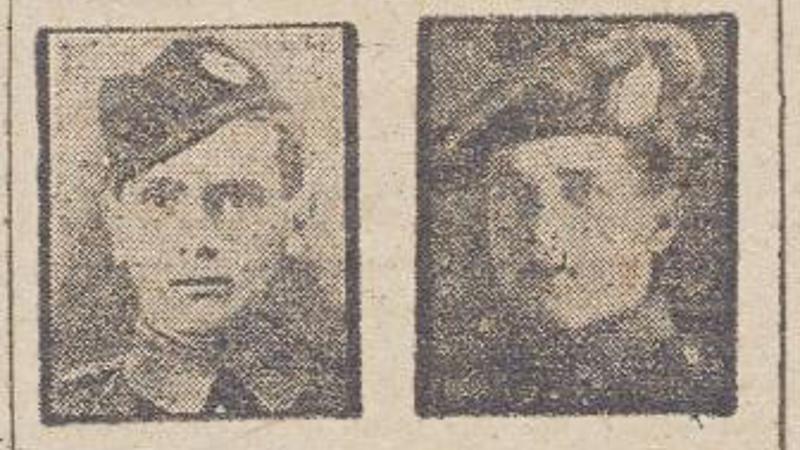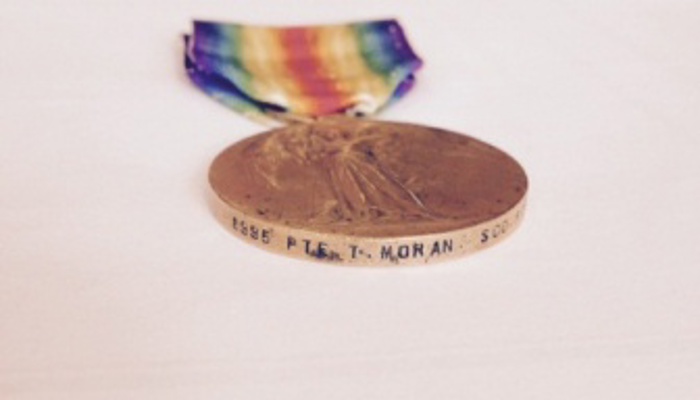
Thomas Moran 1897 - 1918

The story of how one family finally discovered the fascinating history of their "Uncle Tommy".
This is the story of how his family built up a picture of his life using resources from the Family History centre at the Mitchell Library, as well as personal effects and oral history.
On Monday September 27th 1918, Private Thomas Moran, of the Scottish Rifles was commemorated in the Evening Times Roll of Honour. He had died of wounds on 9th September in Regents Park hospital, Southampton.
Thomas Moran was born at almost midnight on June 28th 1897 at 264 Main Street, Maryhill. His mother, Mary and father, Laurence, a bonded warehouseman, had been married in Wexford, Ireland in 1892, and by 1911, had moved to 44 Murray Road, Glasgow, via Garscube Road, Glasgow, as well as Alloa. They had had a family of 13 children, with 10 still living at the time of the 1911 census.
The search
Teresa Graham is Thomas’ great niece, pictured below, with her father, Jim, who remembers his Gran, Mary talking about “Uncle Tommy”.
Teresa told me: “I had always been fascinated by a medal in my mother’s jewellery box, inscribed with Thomas’ name and regimental number. I used to take it out and look at it, and I even took it to the Brownies on Remembrance Sunday. It had no ribbon, and after a visit to the Barras, my dad was able to buy a new one”.
As the years passed, the family began to find out more about Thomas. Teresa and her father contacted Hamilton Museum for the medal award card, and found his name on the Cameronians Roll of Honour. Teresa then contacted us in Special Collections to find out where Thomas was buried. After searching the burial records, we discovered he was laid to rest in St Kentigern's Roman Catholic Cemetery.
We then checked the Evening Times Roll of Honour, a daily item, which listed intimations by families of the men who perished during the war of 1914 – 1918. This has been painstakingly indexed by library staff over the past decade. We were delighted to find that the entry contained a photograph.
Thomas Moran's medal and Census listing



Filling in the blanks
It is sometimes too easy to think of ancestors as merely names and dates in a document. In order to imagine Tommy’s life in Belgium, as part of his regiment, We decided to have a look at our Scottish Regimental Histories collection to illuminate some of Tommy’s last days.
According to Colonel JM Findlay’s account With the Eighth Scottish Rifles 1914 – 1919:
“On 6th August 1918, we entrained at St Maro Station for an unknown destination. Finally, we detrained the following day at Wormhoudt, comfortably settled ourselves there, and pursued general training until 13th August. We overhauled our kits and received new drafts, which brought us up to goodly numbers again. We had the privilege of a glimpse of His Majesty the King.
We marched off from Wormhoudht on 13th August, and reached the School Camp of St Janster-Beisin at 2pm the same day. Here we remained three days only, to move on again to “Dirty Bucket Area”. These marches were carried out by order of the B.G.C (Brigadier-General Chaplin, an old Cameronian), with the strictest possible march discipline.
Our next spell in the line was just in front and in full view of Kemmel Hill, where we took over an area where the trenches were but a series of manholes. During our spell here, the line was advanced a distance of 100 yards. We suffered casualties mainly from shell fire, and had the great misfortune to lose a number of valuable Head-quarters Signallers, into whose dug-out a shell landed with disastrous effect. We had no better type of man in the battalion.
Otherwise the war, as far as we were concerned at the time, was comparatively quiet, though nasty rumbling noises were heard day and night over the whole Ypres salient. It required only a cursory look at the map and at the progress of the troops around us, to foretell that our opportunity was daily approaching nearer and nearer.
On 5th September, we were relieved and moved into Sherpenburg Reboubt. The quarters here were merely rabbit-warren dug-outs, with no overhead protection, and all were flooded out with rain which fell unceasingly. Being placed on the guarded side of hills and hummocks, they afforded a little protection from shell fire, which reached its maximum as darkness fell.”
The regiment moved on to Eperlecques, Steenvoorde and Hallebasse. They moved on without Thomas Moran, who was poisoned by gas during an attack, and was conveyed to Southampton, where he died at Regents Park Hospital on 9th September 1918.

Thomas Moran's gravestone
After an emotional email, where we learned that the family had never seen a picture of “Uncle Tommy”, the family were able to visit the grave, and lay flowers in his memory.
Wages
According to the Army Registers of Soldiers' Effects, 1901-1929, after his death, Tommy’s mother, Mary, was paid wages and War Gratuity, on her son’s behalf. On 17th December 1918, she received £19 and on 17th June 1919 she received a further 15 pounds, 3 shillings and four pence.
Teresa again: “I hated to think of the grave having been there all that time, without us knowing about it. The medal and photograph mean a lot to me, and the research we have done has brought our family closer to the memory of Uncle Tommy.”
Family History facts
To build up the picture of Tommy’s life, we used a number of resources in the Family History Centre and Special Collections of the Mitchell Library.
- Scotland’s People
- Ancestry Library Edition
- Scottish Regimental Histories Collection
- Newspapers Collection
- Burial Records
Please contact us if you would like to talk to us about starting work on your own family history, or about the Evening Times Roll of Honour.
